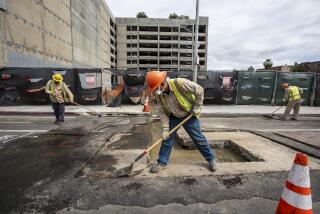A Fatal Illness Made More Terrible
Somebody put a curse on Carlos Ramos, or so he thought. Sometimes, without warning, he would forget how to walk. He couldnât swallow water without choking and sometimes couldnât grasp objects.
At his job with a downtown Los Angeles moving company, the 34-year-old Honduran stumbled occasionally and slurred his speech, leading his bosses to think he was a drunk. They fired Ramos, plunging him and his family into poverty.
Nobody knew Ramos was dying. He didnât find out until a doctor last year finally diagnosed him as having the incurable neurological disorder commonly known as Lou Gehrigâs disease.
Ramos, who spent most of his life in a Honduran village until he immigrated here in 1993, didnât understand. He wanted to know: Who is Lou Gehrig?
The answer is easy for many of the about 30,000 people in the country who suffer from the disease--medically known as amyotrophic lateral sclerosis, or ALS.
But for recent immigrants like Ramos, such a question reveals the surface of deep confusion felt by thousands about an obscure illness that has the worldâs brightest doctors at a loss for cures or even its cause.
There are immigrants throughout the country living with the illness that slowly eats their muscles to the bone, sometimes for years, before ending in paralysis and the inability to breathe. Yet, experts say they usually donât know they are being killed by the disease named after Lou Gehrig, the New York Yankees slugger who first brought attention to ALS when he contracted the disease.
That is why the Greater Los Angeles ALS Assn. is designing new support groups for immigrant communities struck by the illness, an effort that exists nowhere else in the nation.
Meeting monthly inside the Rancho Los Amigos Medical Center in Downey, the first such group was recently launched for Latinos, the largest immigrant group among the about 3,200 Californians diagnosed with ALS.
As a prototype for others to follow, the Latino support group aims to ease the anxieties of patients whose illness they barely understand, said Lourdes Cerna, a counselor at Rancho Los Amigos. Her brotherâs ALS inspired her to initiate the campaign.
The group, for example, teaches CPR to family members, and swallowing therapy for patients. They provide a place for family members to talk about the trauma of seeing a loved one slowly dying. For patients, there is counseling for the gradual loss of physical and mental abilities.
Typically, immigrants with ALS and their families are confused about the disease and its treatment, group members said.
âWe had to go through this on our own,â said Christina Gonzalez, of Santa Ana. Her Mexico-born father harangued her for months, saying, âFind me a cure!â before dying last year of the disease.
âI had to tell him myself that he had eight months to live because the doctor couldnât speak Spanish,â she said. âThatâs probably one of the hardest things Iâve had to do.â
In addition to language barriers, there are cultural misunderstandings. âMany Latinos with ALS believe that they have been cursed or that God is punishing them for something theyâve done wrong,â Cerna said. âThey have this overwhelming sense of guilt.â
Ramos is racked with anxiety over his condition and has evidence to believe heâs cursed. Once close to owning a home, he and his family had to move into public housing at Jordan Downs after he could no longer work.
He has trouble speaking and walking. Ramos realizes he is dying but nonetheless feels he should be working to support his family. Instead, he said, he can only watch the muscles of his once powerful body turn to mush. He said he is weaker than his 20-month-old son, Carlos Jr.
âIâm used to being an independent person,â Ramos said, sitting by a living room table littered with unpaid bills.
Ramos has Medi-Cal insurance that pays for his ALS treatments. But even with the insurance, the stress of being a burden to his family instead of the breadwinner is wearing him down.
Ramos spends his days at home with Carlos Jr. and his wife, Ana Hernandez, who recently quit her job at a sewing factory to care full time for the family. They get help in form of food and monetary donations from friends and a nearby church. They share their apartment with two teenage sons from a previous marriage.
They are looking for new housing because the coupleâs two-story apartment is not outfitted for an ALS patient. The only bathroom in the home is upstairs from the living room where Ramos spends most of his day watching TV or staring out the window. The trip up the flight of 15 stairs can take Ramos 20 minutes, he said.
When he is alone, he said, âI crawl up with my arms.â Sometimes Carlos Jr. tries to help.
These days, Ramos said, he appreciates beauty in the simplest things: his toddlerâs breath and the boyâs baby powder scent. âEvery day is a poem with him,â Ramos said.
Carlos Jr. knows to be careful around his father. âHe understands something is happening to me,â Ramos said.
Ramosâ condition makes him subject to uncontrollable outbursts of emotion. When provoked, he sometimes breaks into long fits of laughter or tears, he said. Doctors say it is a common problem among ALS patients as their brains deteriorate.
At night, the rattle of gunfire at Jordan Downs sometimes reaches Ramosâ bedroom. Each time, he shifts awake, terrified, his eyes wide open, unable to move his cramping body.
âHe cries like a baby,â his wife said. âEspecially when he hears noises coming from downstairs.â
Their home was recently burglarized, she said, while the family lay asleep upstairs. When they awoke, Hernandez said, they discovered that somebody had come in through the kitchen window and taken her purse.
More important than the few dollars inside, the thieves took documents essential to the family, including Ramosâ green card and driverâs license, Hernandezâs California identification, as well as the title and insurance papers for their 1987 Dodge van.
The burglary, Ramos said, âhas made me feel very vulnerable. If somebody comes in again, what can I do? I cannot protect my family.â
Pride made Ramos take the wheel of the family van in October, although he is no longer supposed to drive. They were en route to their first support group session.
They were stopped at a sobriety checkpoint station. Ramos tried to explain in broken English that he was due at the hospital. His speech was slurred, so the officer asked to see his license and registration, which Ramos did not have. Police determined Ramos was sober, but they impounded the van, which remains at a police tow yard.
Stranded miles from home, Ramos walked with his wife for a while, then sat on a curb for hours and cried.
More to Read
Sign up for Essential California
The most important California stories and recommendations in your inbox every morning.
You may occasionally receive promotional content from the Los Angeles Times.





![[20060326 (LA/A20) -- STATING THE CASE: Marchers organized by unions, religious organizations and immigrants rights groups carry signs and chant in downtown L.A. "People are really upset that all the work they do, everything that they give to this nation, is ignored," said Angelica Salas of the Coalition of Humane Immigrant Rights. -- PHOTOGRAPHER: Photographs by Gina Ferazzi The Los Angeles Times] *** [Ferazzi, Gina -- - 109170.ME.0325.rights.12.GMF- Gina Ferazzi/Los Angeles Times - Thousands of protesters march to city hall in downtown Los Angeles Saturday, March 25, 2006. They are protesting against House-passed HR 4437, an anti-immigration bill that opponents say will criminalize millions of immigrant families and anyone who comes into contact with them.]](https://ca-times.brightspotcdn.com/dims4/default/34f403d/2147483647/strip/true/crop/1983x1322+109+0/resize/840x560!/quality/75/?url=https%3A%2F%2Fcalifornia-times-brightspot.s3.amazonaws.com%2Fzbk%2Fdamlat_images%2FLA%2FLA_PHOTO_ARCHIVE%2FSDOCS%2854%29%2Fkx3lslnc.JPG)




